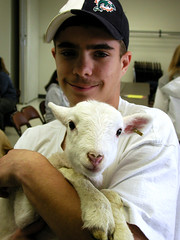- Sheep 201 Index
- Other web sites
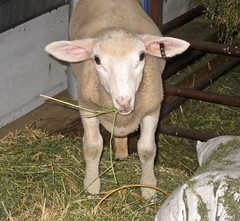
Munching on hay

Tunis lamb

Geriatric George
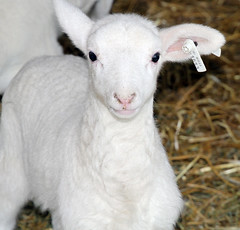
Steven
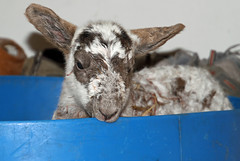
Day old lamb

4 year old wether

Peter
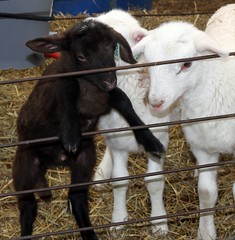
Bummer lambs
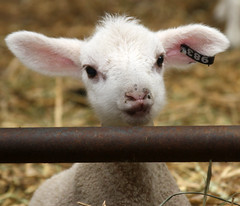
Little fellow
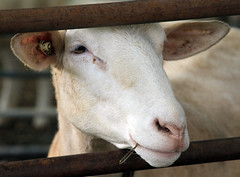
Mature ewe
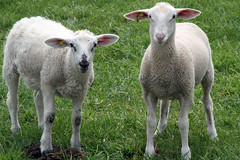
Lambs on pasture
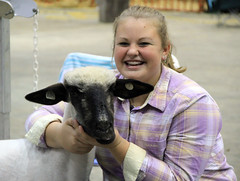
Shropshire lamb

Lance
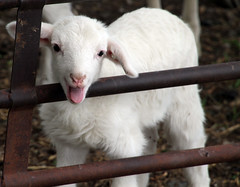
Benjamin
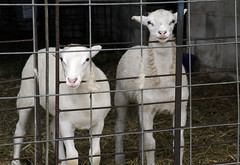
Big orphans
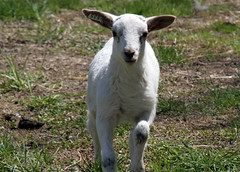
Skippy
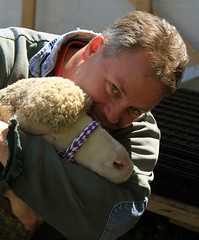
Loves his sheep
Keeping sheep as pets
Sheep are sometimes kept as pets or companion animals, as they are easy to handle and valued for their docile nature. As with any pet, the decision to keep sheep as pets should not be done on an impulse. It is important to learn as much as you can, so that you can make an informed decision.
First of all, you need to make sure your zoning regulations or housing covenants allow you to keep farm livestock. Both may restrict the size or number of animals that you can have. They may also prohibit the keeping of sheep. Increasingly, zoning regulations are being revised to allow people to keep small livestock.
You need to consider if you have enough time to care for sheep. You need to have a plan for their care if you go out of town or become incapacitated. You also need to have an exit plan: what will you do with the sheep if they do not work out or you don't want them anymore? Sometimes, it can be difficult to get people to adopt pet sheep, especially in a timely fashion.
What kind of sheep?
Any breed of sheep can be raised as a pet or companion. It is usually a matter of personal preference or sometimes the result of circumstances. Mature size varies considerably among sheep breeds, from less than 100 pounds to over 200 pounds. Soay (ewes weighing only 50 lbs.) and Olde English Babydoll Southdown (18-24 inches tall) are two of the smallest breedsThe Shetland is another small breed.Hair sheep are probably the best good choice because they do not require shearing or docking. Their coats contain a mixture of hair and wool that sheds annually. They are also more tolerant of heat and more resistant to worm parasites. Crossbred sheep are a better choice than purebreds because of "hybrid vigor." In other words, they are hardier and more disease-resistant, just like "mutt" dogs. They are also usually less expensive to purchase. Heritage or other landrace breeds are another good choice for pets, especially if you plan to breed your sheep.
Females (ewes) or wethers (castrated males) are recommended for pets. Intact males (rams) are not recommended as pets. Rams get larger and usually become aggressive, especially during the rut (breeding season). Naturally polled (hornless) animals are also advised. While many sheep are polled, there are some breeds in which males and sometimes females can carry horns. Neutering may diminish horn growth in horned males. Horned animals can get their heads stuck in fences and feeders and can cause injury to other animals and people.
Sheep are social animals. They should not be raised singly. It is best to keep them in flocks. It takes about five sheep for sheep to display their natural flocking instinct. In the minimum, pet sheep should be kept in pairs. They can also be kept with other livestock, especially goats, but their preference is their own kind. When sheep are co-mingled with other livestock, you need to make sure they do not consume feeds or mineral mixes that have been formulated for other livestock and contain added copper. It is not recommended that horned animals be kept with polled animals.
Orphan, poddy, or bummer lambs -- those raised on a bottle or milk bar -- often make the best pets because they will naturally bond to their care giver. This is probably why sheep were domesticated in the first place, before most other animals. However, if you start with orphan lambs, you need to be aware that they are more vulnerable to disease (including worms) their first year because of their often-compromised start in life.
Orphans often do not consume enough colostrum, the first milk produced by the ewe after she lambs. Colostrum helps to jump start the lamb's immune system. Orphan lambs are usually weaned earlier than dam-raised lambs, so they are forced to "grow-up" quicker. By the same token, it is not recommended that orphan lambs be fed a milk diet for an extended period of time. It is best to wean them by the time they are 6 to 8 weeks of age. Abomasal bloat and other digestive problems are common with orphan lambs, especially those raised by inexperienced people.
Fencing/containment
There are many different kinds of fencing that will contain sheep. Besides keeping sheep in, you need to be vigilant about keeping other animals out, including your own dogs. Sheep are a prey animal and are vulnerable to attacks from numerous predators, including domestic dogs and coyotes. If you or your neighbors have pet dogs, especially large breeds, you need to make sure these dogs do not pose a threat to your sheep. With the exception of livestock guardian dog breeds, domestic dogs have a natural predatory instinct: there's a "wolf" lurking under the skin of every dog. Even if dogs do not attack sheep, they can worry them and cause them to abort their offspring. They can also cause needless stress.The most common type of fencing for sheep is woven wire or box wire. Woven wire consists of horizontal wires with vertical stays. The size of the squares created by the wires varies. The smaller squares are better because the sheep cannot get their heads stuck and small predators cannot crawl through. High tensile, electric fences are commonly used on commercial sheep farms, but less practical for small enclosures.
A split-rail or board fence can be used for sheep, so long as the fence is covered with mesh wire or electric wires are put between the boards and between the ground and first board. Barbed wire fences are less desirable for sheep because they can cause injury. Many taught wires would need to be installed in order to contain lambs and deter predators.
It is possible to tether sheep, but this should only be done if someone is nearby to watch the sheep. A tethered animal is vulnerable to predators. A tethered animal can also get tangled in its line or knock its water bucket over. The same can be said for allowing animals to free graze, without fences to contain them. This is only advised if someone is there to watch over them.
Ideally, you should have an acre or two for your pet sheep to graze. An acre is usually enough for a few sheep. If pasture is not available, pet sheep can be kept in small pens or enclosures. Pens can be constructed from various materials. Livestock panels sold at farm supply stores work well if the panels are high enough and the openings are small enough. The pen should include an exercise area of at least 50 square feet. If the lot is smaller than this, it is important to get sheep out for exercise and grazing. Young sheep will enjoy environmental enrichment, i.e. something to jump on. Sheep naturally seek higher places.
Shelter
Sheep should have protection from extreme weather: hot and cold, wet, and windy. Shelters do not need to be fancy or expensive. They just need to provide a place where the sheep can go to get out of the rain, snow, or wind. The shelter will also keep their feed dry. Sheep may seek shelter (or shade) in hot weather, especially if it is humid. Inside the shelter, it should be dry to prevent hoof or other disease problems.Shelters can be homemade or purchased. Three sided run-in sheds work well. Plastic calf hutches or poly domes are popular shelters for small numbers of sheep. Metal port-a-huts are another option. Cloth structures work well for shade. Sheep can even seek shade under solar panels and hay wagons. Small sheep may be able to get shelter in a large doghouse or igloo.
Health care
If fed and managed properly, most pet sheep maintain good health and live for a long time. The natural life span of a sheep is 10 to 12 years. Some will live longer. The most common health problem of sheep, especially lambs, is gastro-intestinal parasites (worms). There are worm eggs in almost every sheep's feces. After the eggs hatch, they developed into infective larvae which the sheep ingest when they graze. Once inside the sheep's body, the larvae develop into adult worms, which lay more eggs, which are again deposited onto the pasture. In the case of the barber pole worm (Haemonchus contortus), the most common parasite affecting sheep, adult worms, along with juvenile worms (L4s), suck the animal's blood. If there are enough worms, they can cause anemia (significant blood loss) and death, especially in young lambs (under six months of age).It is normal for sheep to have parasites of various kinds in their digestive systems. It is only when they have too many that it becomes a problem. You can tell if a sheep has too many barber pole worms by examining the color of its lower eye lid. If the color is pale (white or light pink), it has anemia and needs to be dewormed with effective medicines. Other worms cause digestive disturbances and may cause diarrhea (scours). Fecal tests are not very useful for determining the need to deworm an animal. Instead, you need to look for clinical signs: anemia (pale mucous membranes), bottle jaw (fluid swelling under jaw), weight loss, loss of body condition, diarrhea, dirty back sides, weakness, and anorexia (lack of appetite).
The drugs used to kill worms are called anthelmintics or dewormers. For sheep, the medicines are always liquid formulations (called drenches) that need to be deposited over the animal's tongue, into its gullet. Over the years, the worms have developed resistance to the drugs. For this reason, it is now recommended that only clinically-parasitized sheep (as evidenced by symptoms: anemia, bottle jaw, etc.) be dewormed and that they be given a combination treatment. This means giving a dewormer from each "chemical" class to the sheep.
The dewormers should not be mixed in the syringe but should be given one after the other. A proper combination treatment would consist of albendazole (Valbazen®) + moxidectin (Cydectin®) + levamisole (Prohibit®, Leva-Med®). All of these dewormers are FDA-approved for sheep and can be conveniently purchased from farm supply stores or over the internet. They should be administered with an oral dosing syringe that has a long metal nozzle. A simple plastic syringe will not work unless it has a nozzle attachment. An accurate weight is needed to properly dose a sheep with deworming medicine. It is better to slightly overdose than underdose the dewormer.
Another common parasite that affects sheep is coccidia (Eimeria spp.). Coccidia is not a worm. It is a single celled protozoan parasite. Coccidia is usually more of a problem in confinement than on pasture and is often the result of overcrowding and unsanitary conditions. However, it can still strike down lambs that are pastured. Lambs (1-6 months of age) are most vulnerable, especially around the time of weaning. As with worms, lambs eventually develop immunity to coccidia; in fact, early than they develop immunity to worms. Mature sheep are immune to coccidia but serve as reservoirs of infection.
All mammals can get coccidia, but the strains are host-specific. Sheep get infected when they consume feces from contaminated bedding, feeders, waterers, etc. Coccidia damages the lining of the small intestines, which is where nutrients are absorbed. The most common symptom, though not always, is diarrhea (scours). Lambs clinically-infected with coccidia usually look poor and fail to thrive. Damage can be permanent. Affected lambs can be permanently stunted.
Coccidiostats can be put in the feed and/or mineral to prevent disease outbreaks. Some milk replacers have a coccidiostat. Coccidiostats need to be fed at least 3 weeks before the risk period. Drugs can also be put in the water to treat lambs for coccidiosis or prevent disease outbreaks. No product is labeled for the treatment of coccidiosis in sheep and lambs. Thus, a veterinary prescription is required. You may also need to obtain the drugs from the vet. Bovatec® (lasalocid) and Deccox® (decoquinate) are coccidiostats that are approved to be fed to lambs. They can usually be purchased from feed and farm supply stores.
Occasionally, pet sheep get sick. When a sheep is not feeling well, it may isolate itself and stop eating. You may notice subtle behavior changes. It may be slow to come in from the field or to the feeder. It may hang its head down. Its ears may droop. Teeth grinding is a sign of pain. Limping could be due to a hoof infection or leg injury. If a sheep is off, its temperature should be taken. The normal body temperature of a sheep is 102-103°F. Anything much above this is indicative of a fever and possible infection. Infections are usually treated with antibiotics. Fever and pain are usually treated with anti-inflammatory drugs, including aspirin.
Non-infectious causes of diarrhea can be treated with over-the-counter medications, such as Kaopectate and Pepto-bismal. Immodium should not be given to sheep, because it paralyzes the gut. Probiotics, including plain yogurt, are good treatments for diarrhea, as they will add healthy bacteria to the rumen. In fact, probiotics are always a good thing to give any stressed animal. Digestive upsets, which are the result of too much gas, can be treated with antacids, sodium bicarbonate, or mineral oil. Be sure to consult a veterinarian or experienced shepherd, if your sheep doesn't respond to treatment or you don't know the cause of its ill thrift.
Vaccinations
The only universally recommended vaccination for sheep is for clostridial diseases. A 3-way vaccine (CDT) that provides protection against clostridium perfringins type C & D (enterotoxemia or overeating disease) and clostridium tetani (tetanus) is the vaccine most commonly used. There are also 7 and 8-way (Covexin-8) vaccines that confer protection against additional clostridial diseases.Lambs should be vaccinated twice, followed by annual boosters. If the sheep are bred, the ewe should be vaccinated about a month before lambing, so that lambs can get passive immunity when they drink the colostrum. Because of their immature immune systems, young lambs (less than 1 month) do not respond as well to vaccinations. The tetanus antitoxin can be given to young lambs whose dams were not vaccinated. Lambs need to have protection against tetanus, if they are going to be docked and/castrated, especially with rubber rings.
Clostridial vaccines can be purchased from farm supply stores and over the internet. They are easy to give, with a subcutaneous injection, usually in the armpit. Sometimes, the tissue reacts to the injection and forms an abscess. Pet sheep should be given an annual vaccination for CDT. The only other vaccination pet owners may want to consider is rabies. There is a vaccine for sheep. In most states, a veterinarian must give this vaccination.
Hoof care
Most sheep need their hooves trimmed at least annually. Hoof growth is affected by many different factors. The purpose of hoof trimming is to remove excess growth, so the animal will move freely. Proper hoof trimming will also prevent hoof disease. Most hoof problems are caused by bacteria that invade the hoof. Keeping hooves properly trimmed will help to prevent entry of harmful bacteria. On the other hand, overzealous hoof trimming could give the bacteria an entry point. There is no need to keep hooves trimmed to perfection. On the other hand, failure to trim hooves is one of the primary reasons sheep owners are reported to animal health authorities.A proper pair of hoof trimmers or shears is needed for hoof trimming. The best way to trim a sheep's hooves is while the sheep is tipped onto its rump. There are also sheep "chairs" that will hold the sheep in a similar position. Some farms put sheep in cradles that tilt the sheep onto its side for easy access to the hooves. It is possible to trim a sheep's hooves while it is standing on a table or tied to a post, but sheep tend to resist this approach more aggressively. The sheep can also be held on its side for hoof trimming.
When trimming hooves, avoid cutting off large chunks of hoof. Stop trimming when you see pink. This means you are getting close to the blood supply. Remove any pockets that you see. When you are done, the nail, sole, and heel should be parallel with the growth bands around the outside of the hoof. Its best to trim hooves when they are soft. There are videos on YouTube than can instruct you on how to trim sheep (or goat) hooves.
Shearing
Most wooled sheep require annual shearing. Long wooled sheep may benefit from twice a year shearing. While you can theoretically shear your own sheep, it is best to have a trained professional do it using electric shears (clippers). If you have only one or two sheep or even a small flock, it may be necessary to take the sheep somewhere for shearing. Do not wait until the last minute to contact a shearer. Pet sheep should be sheared in the spring before the onset of warm weather. For pets, it is best to choose sheep that do not require shearing. Failing to shear sheep in a timely manner is an animal welfare concern that could be reported to animal health authorities.Feeding
There are two things to keep in mind when feeding pet sheep. They are ruminants and they are pets. A ruminant has four parts to its stomach. It chews its cud. Its digestive system evolved to digest forages -- fiber and cellulose. Ruminants must eructate (belch) to get rid of fermentation gases, the by-products of their digestive system. Failure to do so can be fatal.A sheep's nutritional requirements depend upon its age, size (weight), and stage and level of production. Weather and activity can also influence nutritional requirements. Cold, wet weather will increase an animal's critical temperature, the temperature below which they must expend calories to maintain their body temperature. Housed animals have lower nutritional requirements that those that free range and live out in the elements. An animal's physical condition can also affect its nutritional requirements. For example, a freshly shorn sheep has a higher energy requirement than one with a fleece, especially in winter. Sheep in better body condition are also more cold tolerant. Sheep are more of a cold weather animal than hot.
Because most pet sheep are mature animals that are not being raised for production purposes, their nutritional requirements are relatively low and can usually be met with strictly forage diets. Pasture or a decent quality grass hay is all that is usually needed. A free choice mineral mix, granular (loose) form and formulated specifically for sheep, will ensure that their vitamin and mineral requirements are being met. Free access to plain salt is a minimum. Small amounts of grain can be fed as a treat. Other suitable treats include leaves, corn husks, bread, and produce in small amounts.
Lambs, because they are still growing and developing their immune systems, will benefit from some supplemental (grain) feeding. As a sheep gets older, its protein requirements diminish. For example, alfalfa hay is too rich for adult sheep, unless they are nursing lambs. With age, sheep also need to consume less feed relative to their body weight. One of the biggest challenges to keeping sheep as pets is keeping them from getting too fat.
It is not healthy for a sheep to be fat. They are less likely to get fat if they are consuming a strictly forage diet: hay, grass, browse, etc. They are also less likely to experience any health problems if they are eating forage diets. While sheep can safely be fed concentrates (grain) in production situations, grain feeding makes sheep more susceptible to various diseases including acidosis, bloat, enterotoxemia, urinary calculi, and polio.
To keep pet sheep from getting too fat, it may be necessary to restrict their grazing time or limit the amount of hay you feed them. If they are given free access to feed, they will likely eat more than they need. Geriatric sheep, on the other hand, may need extra feed or special feed that is easy to digest. Older sheep may not have any front teeth (incisors), though their molars will still allow them to chew. Sheep without front teeth have a more difficult time grazing short pastures.
If grain is fed, it should be a feed that is 100 percent nutritionally-balanced for sheep or lambs. It should not be feed that is balanced for other livestock or marketed as a general livestock feed. Sheep have a low tolerance for excess copper in their diets and should generally not be fed formulations with added copper. Nothing should be added to complete feeds, as they are already nutritionally-balanced. Wethers are particularly susceptible to urinary calculi (kidney stones), which is caused by an imbalance of calcium to phosphorus. Adding corn to an otherwise balanced ration could put male sheep at risk, as corn is high in phosphorus and low in calcium.
Urinary calculi is a very common problem with pet (male) sheep. Feeding a forage (pasture + hay) diet will prevent almost all cases of urinary calculi. If grain is fed (first year only), it must be properly balanced for calcium and phosphorus. Many lamb feeds contain ammonium chloride. This is a urine acidifier that helps to prevent urinary calculi. It is also important that sheep consume enough salt and drink enough water. Free choice salt or minerals will encourage consumption of both. Some people think urinary calculi think early castration causes urinary calculi, when in reality, it is a nutritional problem.
If you breed your pet sheep, you will need to feed them according to their nutritional requirements for gestation and lactation. All feed should be offered in a trough or manger. Sheep should not be allowed to eat feed off of the ground. Sheep will generally not eat feed that has been soiled.
It goes without saying that sheep should always have access to plenty of fresh, clean water. Unlike other livestock, sheep (and goats) will not drink dirty water. Sheep drink less water than other livestock because they lose less water in their urine. Adequate water intake is necessary to maintain health. In particular, it will help to prevent urinary calculi in wethers. Sheep will drink more water in the winter if it is ice free and warm. They will drink more in the summer if it is cool.
Keeping Sheep as Pets
<== SHEEP 201 INDEX
Copyright© 2021. Sheep 101 and 201.

